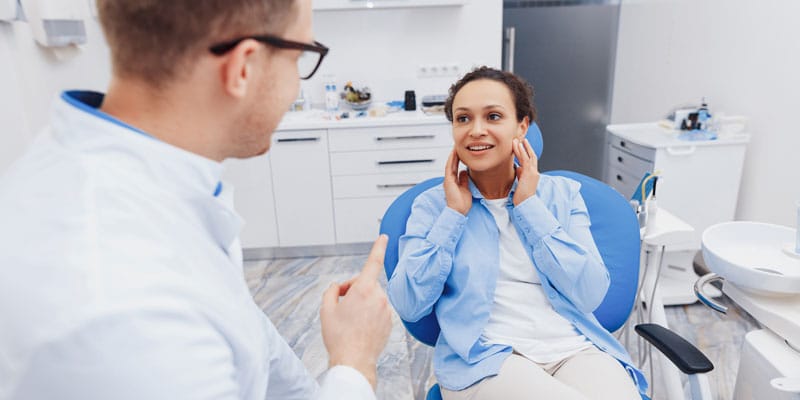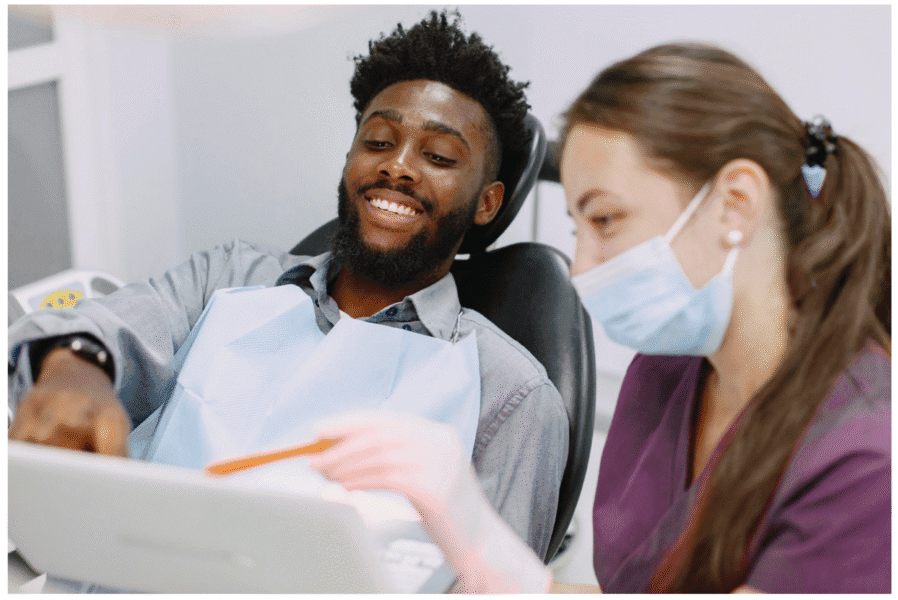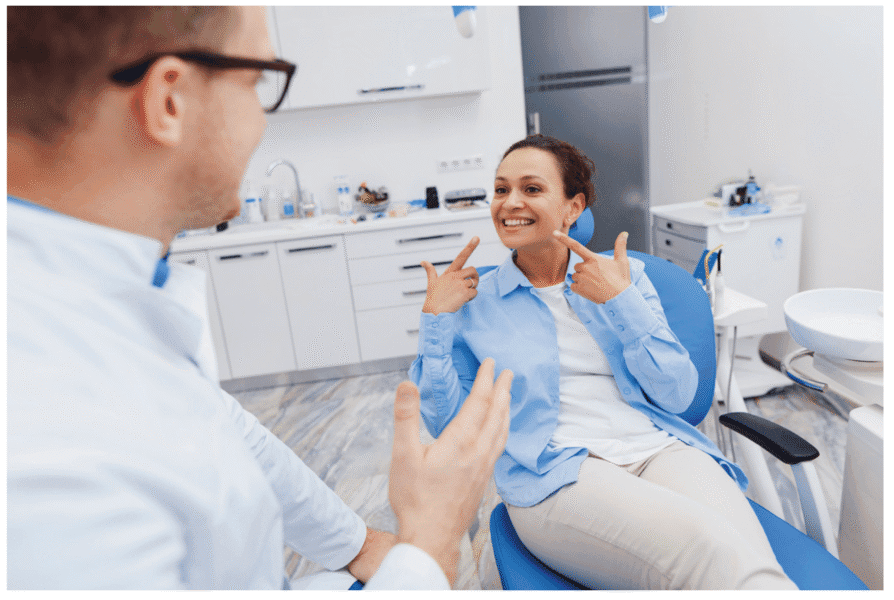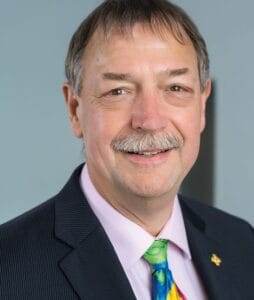CE Expiration Date: August 15, 2028
CEU (Continuing Education Unit):2 Credit(s)
AGD Code: 730
Educational Aims
This self-instructional course for dentists is to empower the clinician to improve patient understanding and acceptance of the choices they have once diagnosed with a medical problem. By drawing out their story, the healthcare provider can match scientific expertise with what matters to the person they serve. Techniques for achieving this preferred outcome have been described for many years; putting them to work enhances our community health.
Expected Outcomes
Dental Sleep Practice subscribers can answer the CE questions online to earn 2 hours of CE from reading the article. Correctly answering the questions will demonstrate the reader can:
- Use lessons from Improv acting to connect with patients
- Enhance listening skills for themselves and their team
- Consider how science and human connection must both be used in today’s medicine

by Steve Carstensen, DDS
Betty looked at me expectantly. I sensed her curiosity about how I, a dentist, could help with what her physician said was a serious problem putting her health at risk: sleep apnea.
My objective is to provide therapy unique to dentistry that mitigates risk diagnosed by a colleague and to empower the suffering human to be involved in their own health solutions.
You may find yourself in a similar situation. This essay will show you how experts in communication, teaching, and making connections between people advise us to narrow the gap between the curious people we serve and the experts we have trained ourselves to become.
Why a New Approach is Necessary
For thousands of years, healers used intuition and thoughtfulness about what they could observe to guide their ministrations. They used techniques such as bloodletting and trephination that seem barbaric today. People put themselves in the hands of those healers because they trusted their decision-making and recommendations. There were connections between those who put themselves out as learned thinkers and those who needed someone to give them hope for healing their afflictions.
It remains so, today. Advancements in science have given healers more and better tools. With information comes a different perspective. Increasing knowledge in a narrow field allows the healthcare expert to comprehend much more about potential troubles and the implications of every treatment choice. It’s still a matter of building a trust relationship.
Our patients have not studied what we have; their expertise, no less important than ours, lies with their own lives and how disruptions to homeostasis have affected them.
Peter Atila, MD, writes in Outlive about the concept of ‘Medicine 3.0.’ He labels the early days of medicine as ‘1.0,’ informed only by what was observable by the eye and guessed at by the healers. Some of it was right – Hippocrates told us that both excellent medicine and bad medicine can be found in food. Other teachings, such as opening holes in skulls to let out the bad spirits, would be set aside as science produced ‘Medicine 2.0.’
As germ theory became widely known in the 19th century, (2000 years after Hippocrates!), it became possible to fully implement Sir Francis Bacon’s 1628 description of the scientific method. Observe, form a hypothesis, test, then consider what you’ve learned. For the first time, physicians could point to a cause of many diseases of the day, such as polio, and develop treatments aimed at the reason for the affliction, moving upstream from treating symptoms only. Medicine 2.0 describes the use of this method, with its highest form being randomized control trials (RCT). Once a patient, or a test subject, has a disease, it is easy to design an experiment where placebo is compared to an active treatment and see which has the most effect. This works very well when an organism, such as a bacteria or virus, is the acute cause of the disease. Healthcare professionals prescribe the same drug to everyone with the conditions detailed in the RCT.
Cardiovascular problems, writes Atila, are chronic diseases that build over years and decades, and, once they become entrenched, are hard to make go away. Medicine’s attention is turning toward prevention of the conditions from which chronic disease arise.
Medicine 3.0 places a far greater emphasis on prevention rather than treatment. It considers each person as a unique individual and shifts how both patient and provider assess the disease. New thinking leads the professionals and the patients to honestly assess risk and accept that no choice is risk free, including doing nothing.
Betty, (remember Betty? This is a story about Betty) waiting for me to say something, has a chronic disease. I know from the literature (Medicine 2.0) that CPAP is considered the ‘gold standard’ for treating sleep apnea and is recommended as first line therapy for nearly everyone diagnosed with the disease.
Medicine 3.0, however, complicates this simple diagnose-treat-assess pattern with curiosity about Betty, how she suffers from the chronic disease, and what she is willing to do to lower her risk.
Inviting the patient’s story to be part of the encounter has been taught since ancient times, documented by Aristotle and popularized by Dr. L.D. Pankey.
Why Curiosity is Necessary
As the sleep expert, I am qualified to study the facts of the diagnosis, follow the prescription by the physician, and choose which dental device is the best match for the patient’s condition. (It may change because insurance won’t pay for the ‘best’ one, but that’s another matter entirely.) None of these decisions are based on the patient’s input about what they want. I’m as likely to choose poorly as wisely.
Betty has her own story. She may not want to have any metal in her mouth. She may be focused on keeping medical devices exceptionally clean. Many years ago, a new patient in my office was adamant that they needed help keeping their mouth closed at night and asked for a device that would manage that for them. Later the same day, a different patient insisted their new oral appliance must allow them freedom to open their mouth easily.
Inviting the patient’s story to be part of the encounter has been taught since ancient times, documented by Aristotle and popularized by Dr. L.D. Pankey in his Philosophy of the Practice of Dentistry. Dr. Pankey taught that we must get to ‘Know our Patient’ prior to developing a treatment plan. In his day he provided a list of questions, not for the patient to fill out but to begin a conversation. The challenge of such conversations is to keep the two experts, one professional, one suffering, from talking over each other and failing to exchange the important details that lead to mutual decision making. This necessary process has been called Co-Discovery.
Perhaps first noted by Dr. Bob Barkley in his book Successful Preventive Dental Practices, Co-Discovery involves asking the patient questions about their history and why they are seeking care now. The dental auxiliary dutifully records the answers and guides the patient through the process. When the interview is nearly complete, the dentist joins to reinforce what is becoming known, invite corrections, and draw out details important to be said.
The critical skill for the professional staff in this scenario is listening. One of Dr. Barkley’s students, hygienist Mary Osborne, has been teaching for many years a listening exercise for dental teams called “Staying in the Question.” Here is a summary; more can be found at her website, listed in the references below.
The dental team separates into partners. One is designated the first speaker, the other the first interviewer, asking questions. They sit knee to knee for better focus.
First question: ‘So that we can work well together, what would you like me to know about you?” This begins a 6 – 7-minute dialog between the partners that has a critically important feature: Once the first speaker answers, all subsequent questions must be directly connected to the partner’s response to the previous question. If they talk about a health goal, the next question cannot be about their family. Interviewers cannot talk about themselves.
After 6 – 7 minutes, the pair thank each other, stand, switch chairs, and assume the other role. Same first question, same process.
At the end of the second interval, the team reassembles and the leader invites comments about ‘What did you notice?’ and ‘How was that for you?’ Mary Osborne instructs us to stay in the question, asking ‘What else?’ until there are no more ‘elses’ to be revealed. An important learning point often expressed is how difficult it was, at first, to not talk about themselves when the task was to stay focused on the partner. Ask: “What did you notice when you were able to refrain from interjecting something about yourself?” Someone almost always says they learned something more about their partner that they did not know. This allows your team to feel the usefulness in clinic situations with patients.
Betty wants me to know what is important to her. If I am focused, I will provide her the space and freedom to tell me. I will ask questions and gather critical insight about what she thinks about her health, diagnosis, risk, and willingness to participate in treatment.

Why Asking Questions Needs to be Thoughtful
There are plenty of questionnaires developed to collect data about medical conditions, symptoms, comorbid conditions, and other details necessary for the healthcare professional to consider. None of them were developed with an individual person in mind, so their efficiency is diminished by their lack of specificity.
Edgar Schein wrote Humble Inquiry to explain ‘the fine art of drawing someone out, of asking questions to which you do not know the answer, of building a relationship on curiosity and interest in the other person.’ He has the perspective of a businessman with insights easily applied in a healthcare setting.
Inquiry takes four forms, he writes: Humble, Diagnostic, Confrontational, and Process-Oriented.
- Humble Inquiry acknowledges ignorance on one side of the dialog and uses curiosity to fill the gap. Questions are designed to not influence the result nor to provoke a socially acceptable response. An example for a healthcare office is ‘What brings you here?”
- Diagnostic Inquiry intends to steer the other to provide more information about something they said. It influences their mental process to come up with something of a justification of the Examples include: “How did you feel about that?” “Why do you suppose that happened?” and “What are you going to do next?”
- Confrontational Inquiry inserts the interviewer’s ideas into the conversation, sometimes making assumptions about the speaker’s emotions or thoughts. It takes discipline and proper body language to maintain an equal relationship using this form of inquiry. An example (and contrast) would be the confrontational “Have you thought about going on a diet?” vs. the humbler “What are you doing about your weight?”
- Process-Oriented Inquiry checks in about how the conversation is going; is it achieving the objective of sharing important information. This is often helpful if the interviewer senses confusion in the conversational partner and sharing goes off track. Asking “What else should we be talking about” or “Is there something I haven’t asked that you would like me to know?” are examples of this type of inquiry.
Humble inquiry helps the interviewer to avoid shutting down the person who wants to tell their story by maintaining a more equal relationship in situations where power is often perceived to be unequal. We want our recommendations to be helpful, to solve a problem for the patient. We are not trying to get them to buy a device, we want them to ask for a solution that may include a device as part of the process. It is humbling to accept that the patient has information we need to be successful.
Betty has power, because she possesses that information. Sitting in the doctor’s office, she may not realize that power. Humble Inquiry helps her claim her place and enhances her chance of successful therapy as she sees her shared insights considered and incorporated into her personal treatment plan.
Dale Carnegie said, “People do things for their reasons, not ours. So, find their reasons.”
Why the Order of What We Say Matters
Jim Pride, DDS, was a winemaker, dental school dean, office designer, and efficiency expert. He and his leaders at Pride Institute taught dentists and their teams how to organize their practices into systems to provide optimum patient care and improve business outcomes. While I was in dental school, I went to an ADA meeting and became a Pride fan while he drew diagrams on an overhead projector. (Old, I am) I was later honored to be invited to teach alongside Amy Morgan, who succeeded Dr. Pride as CEO of the company.
Humans are entrained to pay attention to what matters to them. Dale Carnegie said, “When dealing with people, remember you are not dealing with creatures of logic, but creatures of emotion.” And “People do things for their reasons, not ours. So, find their reasons.”
As we consider how to present the information the patient expects from us, using what we know about them has a big influence on what they hear.
These two sentences say the same thing:
“Our custom oral devices are precision made and serve as retainers for your teeth”
“So that your teeth can’t move during treatment, I recommend a precision-made custom device that works like a retainer”
Dr. Pride taught that leading a sentence with something important to the patient will keep their attention through the part where you name the thing and describe its features. He called this a “Benefit Statement.” Notice the first sentence leads with the thing, while the second speaks about a patient concern. Benefit first. What is being proposed, or Procedure, comes next, followed by Features of the procedure/device/service. The patient focuses on ‘what’s in it for them’ with the benefit, endures the procedure (which they probably don’t want), and is emotionally supported by the features of the choice they feel they must make. B + P + F = acceptance. Put the same words in another order, and you lose control. If you begin with the device, you risk the patient distracting themselves with what they think they know about oral appliances, what their friends and family have told them, or what it looks like. You say this isn’t possible in the time it takes for you to complete a sentence? Do you think, or talk, faster? So do they.
Betty is interested in what’s good for Betty, and she wants to stop the symptoms that drove her to get diagnosed with sleep apnea. She sees the oral device only to achieve that outcome, not as the goal itself. If we focus on the process of getting the device perfect, it may mean a lot to us, but not so much to Betty.

Why We Need to Align with the 5 Reasons to Treat
David McCarty, MD, is a sleep specialist who was an English major in college. His clinical work has always included challenging himself to improve communications with his patients. He’s also a writer/cartoonist and co-author of Empowered Sleep Apnea, A Handbook for Patients and the People Who Care About Them. Alan Alda, the actor, wrote a book: If I Understood You, Would I Have This Look on My Face? after a dental encounter that went wrong due to lack of communication by the dentist. Both provide resources for taking complex information and making it accessible for people who are experts only in themselves.
Dr. McCarty includes in his book this lesson: once a person is diagnosed with a sleep related breathing disorder, there are 5 reasons to treat it:
- Risk – what level of health risk to that individual does the SRBD hold, such as a major adverse cardiovascular event?
- Snoring – does snoring decrease quality of life for the snorer or another
person? - Wake – how does the SRBD impact activities during wakefulness – drowsy driving, for example?
- Sleep – what happens to keep sleep from being restful – frequently waking, poor sleep quality, gasping and choking?
- Comorbidities – what chronic disease is the patient struggling with that may be impacted by SRBD?
Alan Alda promotes the tools of Improv to enhance the exchange of information. On stage, improv actors are trained to listen carefully to their scene partners to build the story for the audience. A scene only works when the actors connect, accept each other’s contributions, and add the next layer. This “Yes, and…” technical expertise is invisible because ‘how it works’ is not important; what matters is ‘how it plays.’ Consider each encounter in your office a scene and every patient a partner.
Betty has a medical history that I studied before she arrived. I know what’s bothering her because I asked appropriate questions and listened carefully. When it’s time for me to provide the advice she came for, I draw upon everything I’ve learned about my science and her humanness. I link her story (emotion and self-interest) to a good reason to treat (Medicine 3.0), and together we decide what treatment will give her the best chance of an outcome that solves the problems she feels. End scene. That’s good medicine.
References
- Schein, Edgar H. Humble Inquiry: The Gentle Art of Asking Instead of Telling. Berrett-Koehler Publishers, 2013.
- Attia, Peter, MD. Outlive: The Science and Art of Longevity. Harmony, 2023.
- Alda, Alan. If I Understood You, Would I Have This Look on My Face? Random House, 2017.
- McCarty, David and Stothard, Ellen.Empowered Sleep Apnea, A Handbook for Patients and the People Who Care About Them. BookBaby, 2024
- Mary Osborne RDH. https://maryosborne.com/
 Currently our Chief Dental Editor, Dr. Carstensen co-founded DSP in 2014. He sees clinic patients in Bellevue, WA and is the Liaison to the American Dental Association for Sleep Related Breathing Disorders. As a Diplomate of the American Board of Dental Sleep Medicine, he lectures internationally and is Co-Author of The Clinician’s Handbook for Dental Sleep Medicine, in its second edition by Quintessence Publishing.
Currently our Chief Dental Editor, Dr. Carstensen co-founded DSP in 2014. He sees clinic patients in Bellevue, WA and is the Liaison to the American Dental Association for Sleep Related Breathing Disorders. As a Diplomate of the American Board of Dental Sleep Medicine, he lectures internationally and is Co-Author of The Clinician’s Handbook for Dental Sleep Medicine, in its second edition by Quintessence Publishing.